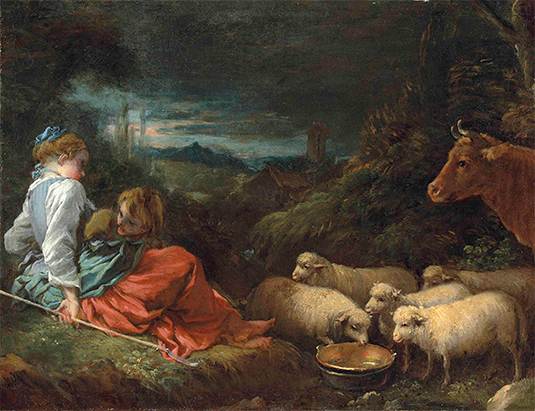
- Home Page
- Accepted
Paintings & Copies - Doubtful
Attributions - Doubtful Textual References
- Alternative
Titles - Collectors &
Museums - Bibliography
- Search Abecedario
- Watteau &
His Circle
X. Les Enfans du fermier
Entered September 2015
Whereabouts unknown
Oil on canvas
29 x 38 cm
ALTERNATIVE TITLES
Un Berger & une bergère
Pastorale
ENGRAVINGS
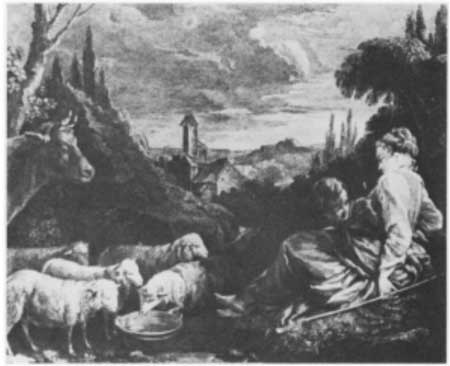
The painting was engraved in reverse by Louis Michel Halbou c. 1755-68.
PROVENANCE
Paris, c.1750-70, where it was engraved by Louis Michel Halbou.
Salzburg, collection of Peter Michael Vigil, Graf von Thun-Hohenstein (1724-1800; bishop of Trento). His wax seal is on the reverse of the picture.
Vienna, Preyer Gallery, c. 1897. This provenance was cited by Ananoff and Wildenstein, and seems to have been derived from notations on an old photograph of the painting.
Berlin, with Kurt Benedikt at the Van Diemen Gallery and then the Lillenfeld Gallery. A certificate from Dr Otto Gratoff, dated Berlin May 1933, places the painting in Berlin in that year.
Canada, with Kurt Benedikt (his name was changed to Curt Benedict).
Canada, Fibiger collection. This indication comes from the Parke Bernet records.
Sale, New York, Parke Bernet Galleries, March 14, 1951, lot 45: JEAN ANTOINE WATTEAU . . . PASTORALE. View of a valley at dusk, with dark clouds. Flocking to a brass pail in the foreground, is a group of sheep, the last days of daylight playing on their backs; at the left a young shepherdess with red skirt, holding a houlette, is resting on a grassy knoll, a boy discernible behind her. (Canadian Private Collection) 11½ x 15 inches Note: A MS certificate by Dr. Otto Grautoff, dated Berlin, May 1933, will be given to the purchaser. Dr. Grautoff writes in part (translation): ‘The landscape and figures are typical of the master and his handwriting is seen in the brush strokes of the faces, hands, and feet. The picture is an exceptionally beautiful example of the master’s early period.’ [See illustration].” The painting sold for $800 to A. J. Perreño.
A.J. Perreño collection. Sale, New York, Parke Bernet Galleries, February 23, 1955, lot 65: JEAN ANTOINE WATTEAU . . . PASTORALE. View of a valley at dusk, with dark clouds. Flocking to a brass pail in the foreground, is a group of sheep, the last days of daylight playing on their backs; at the left a young shepherdess with red skirt, holding a houlette, is resting on a grassy knoll, a boy discernible behind her. (Parreño) 11½ x 15 inches Note: A MS certificate by Dr. Otto Grautoff, dated Berlin, May 1933, will be given to the purchaser. Dr. Grautoff writes in part (translation): ‘The landscape and figures are typical of the master and his handwriting is seen in the brush strokes of the faces, hands, and feet. The picture is an exceptionally beautiful example of the master’s early period.’ [See illustration].” The painting sold for $1,150 to Helen Lurie.
New York, collection of Helen Lurie (1909-2001). Her estate, sale, New York, Christie’s, June 7, 2002, lot 57: “FRANÇOIS BOUCHER . . . ‘Les Enfants Du Fermier’ / oil on canvas / 11½ x 15 in (29.2 x 38.1 cm)/ Estimate $40,000-60,000.
PROVENANCE: / Peter Vigil Graf von Thun-Hohenstein, Bishop of Trient (whose wax seal is on the reverse). / Benedict collection, Canada; Parke-Bernet, New York, 14 March 1951, lot 45, as ‘Jean Antoine Watteau’.
This endearing pastoral by Boucher is one [sic] the artist’s most successful early compositions, a fact attested to by the several autograph versions of it that are known today. The composition was engraved by Louis Michel Halbou (fig. 1: see Pierrette Jean-Richard L’Oeuvre gravé de François Boucher, Paris, 1978, no. 1072, illustrated), probably in the 1750s or 1760s. Halbou’s engraving included the prominent profile of a cow looking fixedly toward a seated shepherd and shepherdess, a feature absent in the version of the painting that was with the Preyer Gallerie in Vienna in 1897 (and reproduced in Alexandre Ananoff, François Boucher, Geneva, 1976, I, cat. 2, fig. 184), but present in a fine, recently discovered version in the Walters Art Gallery, Baltimore (see Eric Zafran, “Paintings by Boucher in the Walters Art Gallery’, The Journal of the Walters Art Gallery, vol. 45, 1987, pp. 103-109). Eric Zafran has suggested that Halbou’s print probably, therefore, reproduced the Walters painting, despite the fact that the Walters canvas is less closely cropped than the engraving and expands the image by several inches on all sides. The rediscovery of the present, previously unpublished painting seems to provide the explanation: it corresponds precisely in form and detail to Halbou’s print, including the presence of the cow’s head on the far right of the canvas, where it can be seen dimly emerging from beneath the layers of nineteenth-century overpainting that had attempted to obscure it.
That the present painting is certainly the engraved picture and is of ‘superior quality’ does not necessarily mean that it is Boucher’s first version of the composition, however, as
Alastair Laing has noted (written communications, 12 December 2001 and 5 February 2002). The composition appears in several of the most important French picture collections of the late eighteenth century, and it can be found passing through the sales of Godefroy (15-19 November 1785, lot 46); the Comte de Vaudreuil (26 November 1787, lot 76); and Montesquiou (9 December 1788, lot 234). It is impossible to say with certainty whether the accompanying sales catalogues describe the Walters painting or another, as yet to be identified version of the composition. (One can be certain only that they do not refer to the Preyer Gallerie version, as each catalogue notes the presence of the cow.) The fact that the present lot bears the seal of Peter Vigil Graf von Thun-Hohenstein, who served as Bishop of Trient from 1776 until 1800 would seem to preclude its presence in the aforementioned collections. Furthermore, the dimensions listed for the picture that appeared in the Godefroy, Vaudreuil and Montesquiou sales, and subsequently the Lebrun, Maurice, and Arago sales (23 May 1814, lot 17; 2-3 February 1835, lot 97; and 8 February 1872, lot 5, respectively) were slightly larger than for the present lot (13 x 16 pouces, or approximately 35 x 43 cm.), closer to the dimensions of the Walters painting (37 x 46 cm.).
As the expert at the Arago sale observed, Boucher’s painting was made shortly after his
return to France from a two-year sojourn to Italy (1728-c.1731) and strongly reflects the influence of the sixteenth-century pastorals by the Bassano family that Boucher would have seen there, especially evident in the young painter’s prominent inclusion of characteristically fluffy ‘Bassano’ sheep. As Laing observed (ibid.), the period immediately following Boucher’s return from Italy was a moment when the artist was eagerly repeating his successful compositions in order to establish himself and to make a living, and well before he had the financial security to afford studio assistance. Despite its reliance on Italian models, however, the present work is also reminiscent of the art of Antoine Watteau, whose paintings and drawings Boucher had copied and extensively reproduced in etchings. Indeed, Boucher’s poses for the shepherd and shepherdess are a modified quotation of the couple in Watteau’s playfully erotic painting L’Indiscret (Museum Boymans-van Beuningen, Rotterdam).
We are grateful to Alastair Laing, who examined the painting in person, and Peter Dewar for their assistance in preparing this entry.”
Sold for $93,210.London, Christie’s, July 4, 2012, “the property of a lady,” lot 195: FRANÇOIS BOUCHER . . . Les Enfants du Fermier, / oil on canvas / 11½ x 15 in (29.2 x 38.1 cm) / £50,000–80,000 US $76,000-120,000 / €57,000-90,00
PROVENANCE: / Peter Vigil Graf von Thun-Hohenstein, Bishop of Trient (whose wax seal is on the reverse) / Benedict collection, Canada / Anonymous sale; Parke-Bernet, New York, 14 March 1951, lot 45, as ‘J-A Watteau’ / The Estate of Helen Lurie, Christie’s, New York, 7 June 2002, lot 57 ($93,210 to the present owner).
This endearing pastoral by Boucher is one [sic] the artist’s most successful early compositions, a fact attested to by the several autograph versions of it that are known today. The composition was engraved by Louis Michel Halbou (J.-R., Pierrette, L’Oeuvre gravé de François Boucher, Paris, 1978, no. 1072, illustrated), probably in the 1750s or 1760s. Halbou’s engraving includes the prominent profile of a cow looking fixedly toward a seated shepherd and shepherdess, a feature absent in the version of the painting that was with the Preyer Gallerie in Vienna in 1897 (and reproduced in Alexandre Ananoff, François Boucher, Geneva, 1976, I, no. 2, fig. 184) but present in a fine recently discovered version in the Walters Art Gallery, Baltimore (see Eric Zafran, ‘Paintings by Boucher in the Walters Art Gallery, 45, 1987, pp. 103-109). Eric Zafran has suggested that Halbou’s print, probably, therefore, reproduced the Walters painting, despite the fact that the Walters canvas is less closely cropped than the engraving and expands the image by several inches on all sides. The rediscovery of the present, previously unpublished painting, seems to provide the explanation: it corresponds precisely in format and detail to Halbou’s print, including the presence of the cow’s head on the far right of the canvas.
That this painting is certainly the engraved picture and is of ‘superior quality’ does not necessarily mean that it is Boucher’s first version of the composition, however, as Alastair Laing has noted (written communications, 12 December 2001 and 5 February 2002). The composition appears in several of the most important French picture collections of the late eighteenth century, and it can be found passing through the sales of Godefroy (15-19 November 1785, lot 46); the Comte de Vaudreuil (26 November 1787, lot 76); and Montesquiou (9 December 1788, lot 234). It is impossible to say with certainty whether the accompanying sales catalogues describe the Walters painting or another, as yet to be identified version of the composition (one can be certain only that they do not refer to the Preyer Gallerie version, as each catalogue notes the presence of the cow). The fact that the present lot bears the seal of Peter Vigil Graf von Thun-Hohenstein, who served as Bishop of Trient from 1776 until 1800 would seem to preclude its presence in the aforementioned collections. Furthermore, the dimensions listed for the picture that appeared in the Godefroy, Vaudreuil and Montesquiou sales, and subsequently the Lebrun, Maurice, and Arago sales (23 May 1814, lot 17; 2-3 February 1835, lot 97; and 8 February 1872, lot 5, respectively) were slightly larger than for the present lot (13 x 16 pouces, or approximately 35 x 43 cm.), closer to the dimensions of the Walters painting (37 x 46 cm.).
As the expert at the Arago sale observed, Boucher’s painting was made shortly after his return to France from a two-year sojourn to Italy (1728-c.1731) and strongly reflects the influence of the sixteenth-century pastorals by the Bassano family that Boucher would have seen there, especially evident in the young painter’s prominent inclusion of characteristically fluffy ‘Bassano’ sheep. As Laing observed (ibid.), the period immediately following Boucher’s return from Italy was a moment when the artist was eagerly repeating his successful compositions in order to establish himself and to make a living, and well before he had the financial security to afford studio assistance. Despite its reliance on Italian models, however, the present work is also reminiscent of the art of Antoine Watteau, whose paintings and drawings Boucher had copied and extensively reproduced in etchings. Indeed, Boucher’s poses for the shepherd and shepherdess are a modified quotation of the couple in Watteau’s playfully erotic painting L’Indiscret (Museum Boymans-van Beuningen, Rotterdam).
We are grateful to Alastair Laing who has examined the painting in person, and Peter Dewar for their assistance in preparing this entry.”
The picture bought in.London, sale, Christie’s, July 10, 2015, lot 190: “FRANÇOIS BOUCHER . . . Les Enfants Du Fermier / oil on canvas / 11 5/8 x 15 in (29 x 37.9 cm) / £40,000 – 60,000 $62,000-93,300 / €57,000 -85,00
PROVENANCE: / Peter Vigil Graf von Thun-Hohenstein, Bishop of Trient (whose wax seal is on the reverse) / Benedict collection, Canada / Anonymous sale; Parke-Bernet, New York, 14 March 1951, lot 45, as ‘J-A Watteau’ / The Estate of Helen Lurie, Christie’s, New York, 7 June 2002, lot 57 ($93,210 to the present owner).
This endearing pastoral by Boucher is one [sic] the artist’s most successful early compositions, a fact attested to by the several autograph versions that are known today. The composition was engraved by Louis Michel Halbou (J.-R., Pierrette, L’Oeuvre gravé de François Boucher, Paris, 1978, no. 1072, illustrated), probably in the 1750s or 1760s. Painted shortly after his return to France from a two-year sojourn to Italy (1728-c.1731), this picture strongly reflects the influence of the 16th century pastorals by the Bassano family that Boucher would have seen there, especially evident in the young painter’s prominent inclusion of characteristically fluffy ‘Bassano’ sheep. As Alastair Laing has observed (written communications, 12 December 2001 and 5 February 2002), the period immediately following Boucher’s return from Italy was a moment when the artist was eagerly repeating his successful compositions in order to establish himself and to make a living, and well before he had the financial security to afford studio assistance. Despite its reliance on Italian models, however, the present work is also reminiscent of the art of Antoine Watteau, whose paintings and drawings Boucher had copied and extensively reproduced in etchings. Indeed, Boucher’s poses for the shepherd and shepherdess are a modified quotation of the couple in Watteau’s playfully erotic painting L’Indiscret (Rotterdam, Museum Boymans-van Beuningen).
We are grateful to Alastair Laing who has examined the painting in person, and Peter Dewar for their assistance in preparing this entry.”
Sold for £50,000.
SELECT BIBLIOGRAPHY
Ananoff and Wildenstein, Boucher (1976), 1: cat. 2.
Jean-Richard, L’Oeuvre gravé de Boucher (1978), cat. 1072.
Zafran, “Paintings by Boucher” (1987), 103, 106.
REMARKS
This composition by the young François Boucher (1703-1770) is known through at least three versions, perhaps four. One version was in several significant collections (Godefroy, Vaudreuil, Montesquiou) and passed through Parisian auctions in 1785, 1787, 1788, 1814, 1835, and 1872. The consistency of the descriptions in these sale catalogues suggests that they refer to one painting that remained in the French capital for a century, until at least the late nineteenth century. Either that or, more likely, another, slightly larger version was in Rome by the late nineteenth century, in the collection of Marcello Massarenti (1817-1905). The Massarenti collection in its entirety was bought in 1902 by the Baltimore millionaire Henry Walters, and the painting remains today in the Walters Art Museum. Yet another version of Boucher’s composition has recently appeared on the Paris market on June 20, 2012 and again on March 25, 2015.
The above references probably do not pertain to our version since although it was in Paris in the mid-eighteenth century when it was engraved by Halbou, it was then taken to Austria. In the last years of the eighteenth century it was in the collection of Peter Michael Vigil, Graf von Thun-Hohenstein (d. 1800). His wax seal is on the reverse side of the painting. Vigil’s painting must have remained in Austria in the nineteenth century, as it was in Vienna in 1897 at the Gallerie Preyer. By the 1930s, if not sooner, it was in Berlin with Kurt Benedikt at the Van Diemen Gallery and then the Lillenfield Gallery. Then, just before World War II, the painting was taken to North America by Benedikt. After 1951, when it came up at auction in New York, its movements became more public, as can be seen in the listing of its provenance.
All the extant versions are extremely close to each other save for the lateral sides. Our version is more restricted than the other versions: the shepherdess’s elbow comes close to the left edge of the canvas, and only the head and a limited portion of the cow’s neck manages to get in at the right side. This arrangement corresponds to the engraving by Halbou. In contrast, the versions in Baltimore and on the Paris market include slightly more at both sides: there is a wider space between the shepherdess’ elbow and the left edge of the canvas, and a greater portion of the bull’s body enters the picture at the right.
This picture and the other extant versions of the composition have all been accepted as being autograph. The present painting would normally have no place in a catalogue devoted to Watteau’s oeuvre were it not that at some point in its history, this picture’s correct authorship was lost sight of and, instead, it was attributed to Watteau. In 1933, when the painting was in Berlin, the art historian Otto Grautoff issued a certificate proclaiming it to be a work by the young Watteau. This false attribution then remained in place through the 1950s and perhaps afterward, but by 2002 it was rightly turned back to Boucher.
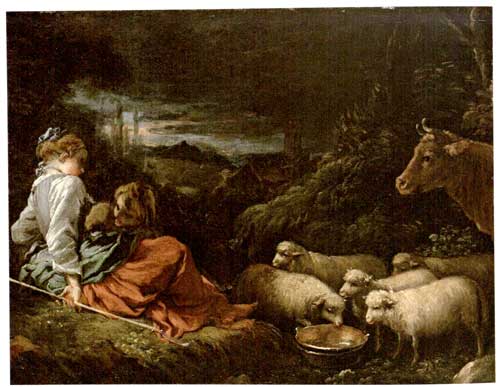
François Boucher, Les Enfans du fermier, whereabouts unknown.
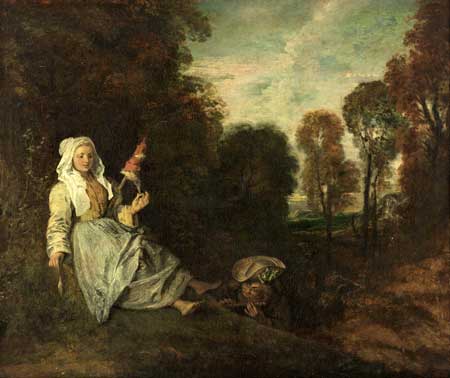
Watteau, L’Indiscret, oil on canvas, 55 x 66 cm. Rotterdam, Museum Boijmans-van Beuningen.
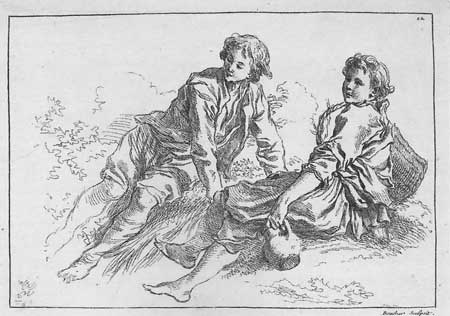
François Boucher, Livre d’étude d’après les desseins originaux de Blomart, plate 12, 1735.
In the recent sales of this painting, a claim has been made that Boucher’s composition contains reminiscences of Watteau’s work, especially his L’Indiscret. While both paintings feature the pairing of a shepherd and shepherdess, they share little in common save for their common descent from Dutch seventeenth-century painting. Indeed, if one were to trace the origins of Les Enfans du fermier, one would do well to turn to Teniers' paintings and to Boucher’s appreciation of the art of Abraham Bloemart (1564-1651). Especially pertinent is plate 12 of Boucher’s Livre d’étude d’après les desseins originaux de Blomart, issued in 1735. That etching shows a similar juxtaposition of two young peasants and emphasizes their mannered, angled poses. Both the etching and Boucher’s painting also feature a comparable squeezing of the girl into the corner of the frame. Watteau’s painting, by contrast, shows none of this and is very different in spirit.
